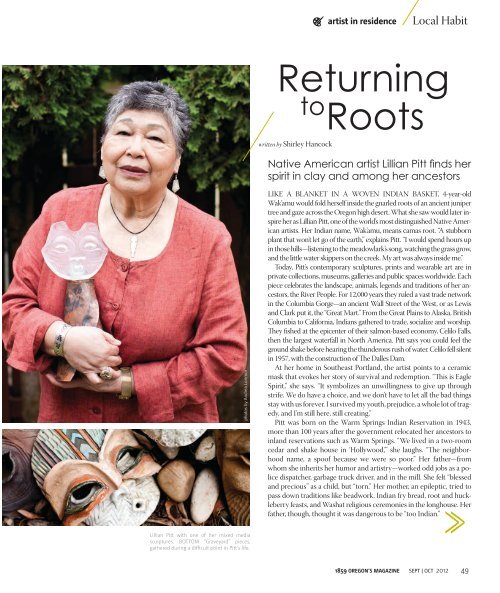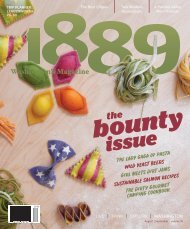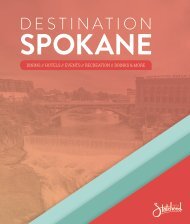Create successful ePaper yourself
Turn your PDF publications into a flip-book with our unique Google optimized e-Paper software.
artist in residence<br />
Local Habit<br />
Returning<br />
to Roots<br />
written by Shirley Hancock<br />
ative American artist illian itt finds her<br />
spirit in clay and among her ancestors<br />
<br />
LIKE A BLANKET IN A WOVEN INDIAN BASKET, 4-year-old<br />
Wak’amu would fold herself inside the gnarled roots of an ancient juniper<br />
tree and gaze across the Oregon high desert. What she saw would later inspire<br />
her as Lillian Pitt, one of the world’s most distinguished Native American<br />
artists. Her Indian name, Wak’amu, means camas root. “A stubborn<br />
plant that won’t let go of the earth,” explains Pitt. “I would spend hours up<br />
in those hills—listening to the meadowlark’s song, watching the grass grow,<br />
and the little water skippers on the creek. My art was always inside me.”<br />
Today, Pitt’s contemporary sculptures, prints and wearable art are in<br />
private collections, museums, galleries and public spaces worldwide. Each<br />
piece celebrates the landscape, animals, legends and traditions of her ancestors,<br />
the River People. For 12,000 years they ruled a vast trade network<br />
in the Columbia Gorge—an ancient Wall Street of the West, or as Lewis<br />
and Clark put it, the “Great Mart.” From the Great Plains to Alaska, British<br />
Columbia to California, Indians gathered to trade, socialize and worship.<br />
They fished at the epicenter of their salmon-based economy, Celilo Falls,<br />
then the largest waterfall in North America. Pitt says you could feel the<br />
ground shake before hearing the thunderous rush of water. Celilo fell silent<br />
in 1957, with the construction of The Dalles Dam.<br />
At her home in Southeast Portland, the artist points to a ceramic<br />
mask that evokes her story of survival and redemption. “This is Eagle<br />
Spirit,” she says. “It symbolizes an unwillingness to give up through<br />
strife. We do have a choice, and we don’t have to let all the bad things<br />
stay with us forever. I survived my youth, prejudice, a whole lot of tragedy,<br />
and I’m still here, still creating.”<br />
Pitt was born on the Warm Springs Indian Reservation in 1943,<br />
more than 100 years after the government relocated her ancestors to<br />
inland reservations such as Warm Springs. “We lived in a two-room<br />
cedar and shake house in ‘Hollywood,’” she laughs. “The neighborhood<br />
name, a spoof because we were so poor.” Her father—from<br />
whom she inherits her humor and artistry—worked odd jobs as a police<br />
dispatcher, garbage truck driver, and in the mill. She felt “blessed<br />
and precious” as a child, but “torn.” Her mother, an epileptic, tried to<br />
pass down traditions like beadwork, Indian fry bread, root and huckleberry<br />
feasts, and Washat religious ceremonies in the longhouse. Her<br />
father, though, thought it was dangerous to be “too Indian.”<br />
P <br />
G <br />
P <br />
<strong>1859</strong> oregon's mAgAzine SEPT OCT <strong>2012</strong> 4

















